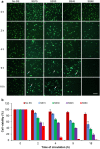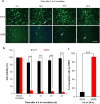High Shear Stresses under Exercise Condition Destroy Circulating Tumor Cells in a Microfluidic System
- PMID: 28054593
- PMCID: PMC5215453
- DOI: 10.1038/srep39975
High Shear Stresses under Exercise Condition Destroy Circulating Tumor Cells in a Microfluidic System
Abstract
Circulating tumor cells (CTCs) are the primary targets of cancer treatment as they cause distal metastasis. However, how CTCs response to exercise-induced high shear stress is largely unknown. To study the effects of hemodynamic microenvironment on CTCs, we designed a microfluidic circulatory system that produces exercise relevant shear stresses. We explore the effects of shear stresses on breast cancer cells with different metastatic abilities, cancer cells of ovarian, lung and leukemic origin. Three major findings were obtained. 1) High shear stress of 60 dynes/cm2 achievable during intensive exercise killed more CTCs than low shear stress of 15 dynes/cm2 present in human arteries at the resting state. 2) High shear stress caused necrosis in over 90% of CTCs within the first 4 h of circulation. More importantly, the CTCs that survived the first 4 h-circulation, underwent apoptosis during 16-24 h of post-circulation incubation. 3) Prolonged high shear stress treatment effectively reduced the viability of highly metastatic and drug resistant breast cancer cells. As high shear stress had much less damaging effects on leukemic cells mimicking the white blood cells, we propose that intensive exercise may be a good strategy for generating high shear stress that can destroy CTCs and prevent cancer metastasis.
Figures








References
-
- Hart I. R. ‘Seed and soil’ revisited: mechanisms of site-specific metastasis. Cancer Metast Rev 1, 5 (1982). - PubMed
Publication types
MeSH terms
LinkOut - more resources
Full Text Sources
Other Literature Sources
Research Materials

